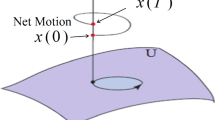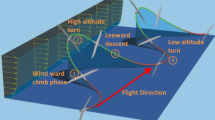Abstract
Angular velocity plays a critical role in determining the outcome of a close-range aerial engagement between two identical fighter aircraft pitching at full deflection. In a zero gravity environment, a pursuer may exploit its ability to roll to increase its relative angular velocity against a pitching opponent. In this paper, we present a repeatable maneuver for an unmanned fighter aircraft that increases its relative angular velocity. Additionally, we provide maneuvers for aligning an aircraft’s trajectory with a desired target trajectory.








Similar content being viewed by others
Abbreviations
- t :
-
Time (s)
- p :
-
The roll rate of our aircraft (rad/s)
- q :
-
The pitch rate of our aircraft (rad/s)
- y :
-
The amount of pitch rate we give up (instantaneously) at the start of our advantage maneuver (rad/s)
- m :
-
Mass of our aircraft (kg)
- v :
-
Speed of our aircraft (m/s)
- \(v_\mathrm{f}\) :
-
Speed of air hitting the wing in the normal direction, caused by rolling (m/s)
- r :
-
Radius of our turn circle (m)
- \(F_\mathrm{c}\) :
-
Centripetal force (lift) acting on our aircraft (\(\hbox {kg}\,\hbox {ms}^{-2}\))
- I :
-
Moment of inertia of our aircraft about the roll axis (\(\hbox {kg}\,\hbox {m}^2\))
- \(\tau \) :
-
Torque generated from wings (N m/rad)
- W :
-
Wingspan of our aircraft (m)
- \(W_\mathrm{d}\) :
-
Width of a wing. Used to approximate drag (m)
- \(C_\mathrm{d}\) :
-
Drag coefficient of our aircraft about the roll axis (dimensionless)
- \(C_{\tau }\) :
-
Drag coefficient of torque drag from rolling the aircraft (dimensionless)
- \(\rho \) :
-
Air density (\(\hbox {kg}\,\hbox {m}^{-3}\))
References
Shaw RL (1988) Fighter combat: the art and science of air-to-air combat, pp 71–74
Bernhart A (1959) Curves of general pursuit. Scripta Math 24:189–206
Merz A (1972) The game of two identical cars. J Optim Theory Appl 9:324–343
Barton JC, Eliezer CJ (2000) On pursuit curves. J Austral Math Soc Ser B Appl Math 41(3):358–364
Merz AW, Hague DS (1977) Coplanar tail-chase aerial combat as a differential game. AIAA J 15:1419–1423
Olsder GJ, Breakwell JV (1974) Role determination in an aerial dogfight. Int J Game Theory 3:47–66
Solinger D (2005) Creating a dogfight agent. Technical Report DKS05–01/ICE 10, Data and Knowledge Systems Group, Faculty of Information Technology and Systems, Delft University of Technology
Ernest N, Carroll D, Schumacher C, Clark M, Cohen K, Lee G (2016) Genetic fuzzy based artificial intelligence for unmanned combat aerial vehicle control in simulated air combat missions. J Defense Manag 06:2167–2374
López NR, Żbikowski R (2018) Effectiveness of autonomous decision making for unmanned combat aerial vehicles in dogfight engagements. J Guid Control Dyn 41:1021–1024
McGrew SJ (2009) Real-time maneuvering decisions for autonomous air combat. Massachusetts Institute of Technology, Dept. of Aeronautics and Astronautics, Cambridge
You D-I, Hyunchul Shim D (2014) Design of an aerial combat guidance law using virtual pursuit point concept. Proc Inst Mech Eng Part G J Aerosp Eng 229:792–813
Chitsaz H, LaValle S (2008) Time-optimal paths for a dubins airplane, pp 2379 – 2384
Owen M, Beard RW, McLain TW (2015) Implementing Dubins airplane paths on fixed-wing UAVs, pp 1677–1701
Larson R, Pachter M, Mears M (2005) Path planning by unmanned air vehicles for engaging an integrated radar network. In: AIAA guidance, navigation, and control conference and exhibit, p 17
Sabelhaus D, Röben F, Peter Meyer zu Helligen L, Schulze Lammers P (2013) Using continuous-curvature paths to generate feasible headland turn manoeuvres. Biosyst Eng 116:399–409
Clements CJ (1990) Minimum-time turn trajectories to fly-to points. Optim Control Appl Methods 11:39–50
Anderson E, Beard R, McLain T (2005) Real-time dynamic trajectory smoothing for unmanned air vehicles. Control Syst Technol IEEE Trans 13:471–477
Author information
Authors and Affiliations
Corresponding author
Rights and permissions
About this article
Cite this article
Deng, B., Collier, T. Increasing relative angular velocity for air combat in zero gravity. AS 2, 83–95 (2019). https://doi.org/10.1007/s42401-019-00030-0
Received:
Revised:
Accepted:
Published:
Issue Date:
DOI: https://doi.org/10.1007/s42401-019-00030-0




